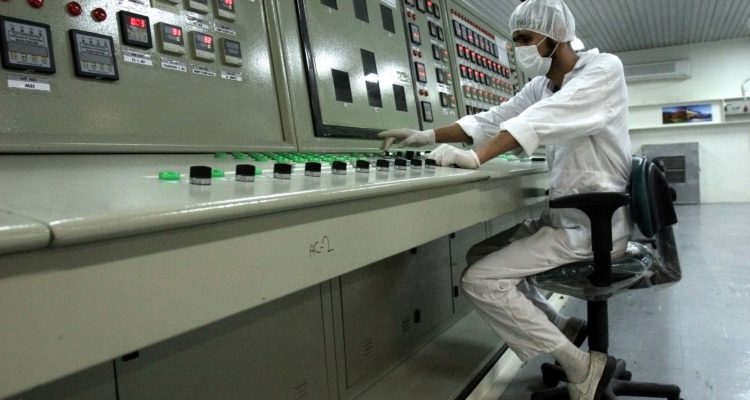The biggest concern is that the more uranium Iran enriches over time, this will begin to narrow the so-called “breakout period” that Iran would need to have enough material for a nuclear bomb.
By Associated Press
Iran is producing even more low-enriched uranium daily than previously thought, after resuming enrichment at an underground laboratory built in a mountain, the head of the country’s nuclear program told The Associated Press on Monday.
Ali Akbar Salehi of the Atomic Energy Organization of Iran attributed the rise to the work at Fordo, a long-secret facility the West feared could be used to divert and rapidly enrich uranium to weapons-grade levels.
Iran resumed uranium enrichment at Fordo as it also broke other limits imposed by the 2015 nuclear deal that began to unravel after President Donald Trump unilaterally withdrew America from the accord over a year ago. Under the nuclear accord, Fordo was supposed to be a research lab — and not used for uranium enrichment.
Iran hopes to pressure Europe through these moves and get European nations to offer it a way to sell its crude oil abroad despite American sanctions. However, President Hassan Rouhani faces growing criticism at home over the accord’s collapse.
Rouhani on Monday separately urged Iran to stick with the deal, saying it could open up international arms sales for the Islamic Republic next year.
Salehi told the AP in Tehran that the country is now producing at least 5.5 kilograms daily (12 pounds). That’s compared to what Tehran had been producing — about 450 grams (1 pound) of low-enriched uranium per day.
The increase in enrichment comes from the inclusion of over 1,000 centrifuges at Fordo, some 25 kilometers (15 miles) northeast of Qom, a Shiite holy city, Salehi said.
Shielded by the mountains, the facility also is ringed by anti-aircraft guns and other fortifications. It is about the size of a football field, large enough to house 3,000 centrifuges, but small and hardened enough to lead U.S. officials to suspect it had a military purpose.
“I believe (that) in total, 5.5 kilograms is the daily volume of uranium enrichment in Natanz and Fordo,” Salehi told the AP, mentioning Iran’s other nuclear facility at Natanz, where over 5,000 centrifuges now spin. Salehi suggested the figure could go as high at 6 kilograms (13 pounds) a day.
Iran currently enriches uranium to up to 4.5%, far below weapons-grade levels of 90%. Uranium enriched to 4.5% can be used at the Bushehr nuclear power plant — Iran’s only one of its kind. Iran began to pour concrete into foundations on Sunday for a second reactor at Bushehr.
The biggest concern is that the more uranium Iran enriches over time, this will begin to narrow the so-called “breakout period” that Iran would need to have enough fissile material for a nuclear bomb — should it choose to build one. Analysts had put that time at a year, under the restrictions of the 2015 nuclear deal.
The United Nations nuclear watchdog, the International Atomic Energy Agency, was expected to release a quarterly report about Iran’s program on Monday.
Iran maintains its nuclear program is for peaceful purposes but the West had pushed for the nuclear deal over its concerns about the program.
Meanwhile, Rouhani’s speech on Monday in the city of Rafsanjan in Iran’s southwest Kerman province was part of a provincial tour ahead of planned parliamentary elections in February. The day before, in Yazd, he faced some heckling from a crowd of hard-liners, despite announcing the discovery of a 53-billion-barrel oil field in the country.
On Monday, he made a point to stress that “by continuing the nuclear deal, we will reach a huge political, defensive and security goal.”
“If we save the nuclear deal, Iran’s arms embargo will be lifted and we can buy weapons or sell our weapons to the world. This is one of the deal’s significant impacts,” Rouhani said.
Under the deal, a United Nations-imposed arms embargo on Iran is slated to be lifted in October 2020, five years after the accord’s adoption.
The end of the weapons embargo, imposed by the United Nations, already worries the Trump administration. The State Department runs a countdown clock on its website to the time when Iran could be allowed to access the international weapons market.
The website also notes that Qassem Soleimani, the sanctioned head of the paramilitary Revolutionary Guard’s expeditionary Quds Force, would be able to travel freely abroad if the measure is allowed to expire.
“Time is running out on international agreements restraining the Iranian regime,” the State Department says. “This could start a new arms race in the Middle East and further destabilize the region and the world.”
However, it remains unclear whether the U.N. would allow the ban to be lifted, given the circumstances the crumbling deal finds itself in today.





